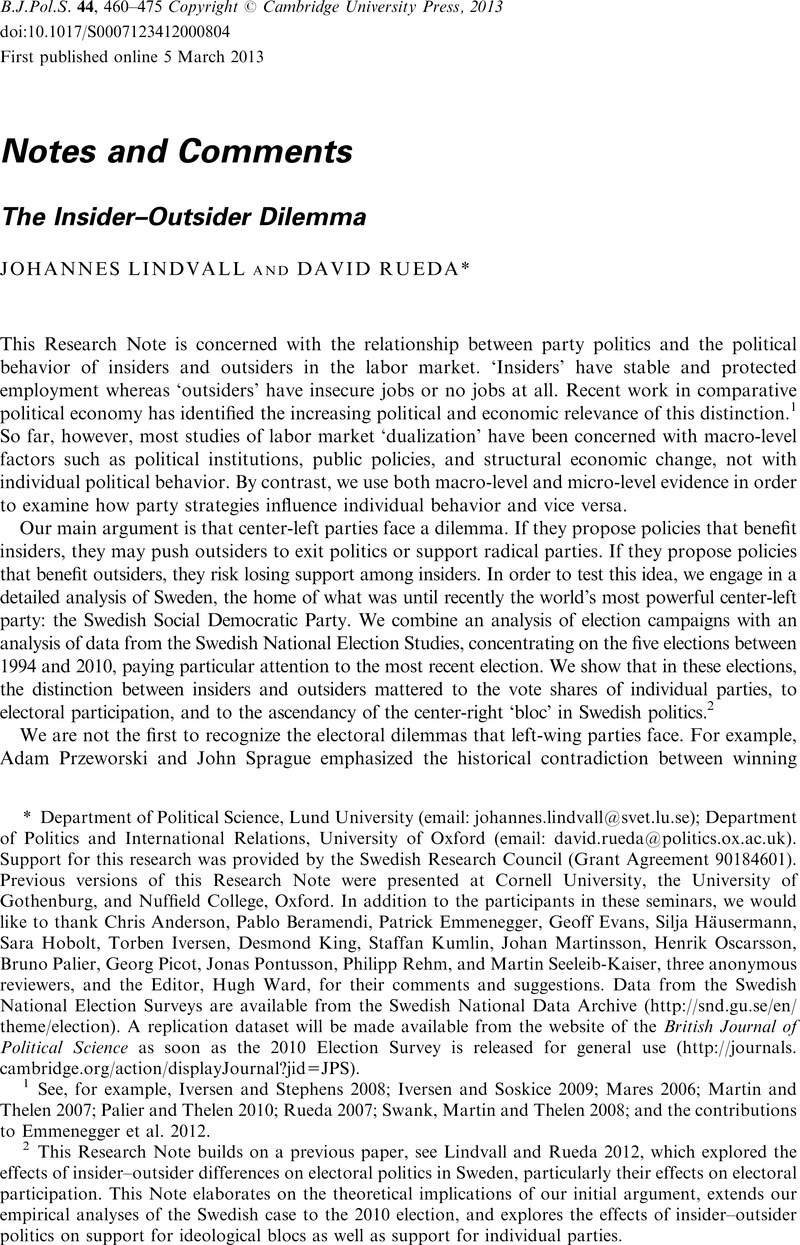Crossref Citations
This article has been cited by the following publications. This list is generated based on data provided by
Crossref.
Lindvall, Johannes
Martinsson, Johan
and
Oscarsson, Henrik
2013.
Party choice in hard times: Group-specific responses to economic downturns in Sweden.
Electoral Studies,
Vol. 32,
Issue. 3,
p.
529.
2013.
Combined References for Electoral Studies Special Edition.
Electoral Studies,
Vol. 32,
Issue. 3,
p.
I.
Alt, James E.
and
Iversen, Torben
2014.
Inequality, Labor Market Segmentation, and Preferences for Redistribution.
SSRN Electronic Journal,
Emmenegger, Patrick
Marx, Paul
and
Schraff, Dominik
2015.
Labour market disadvantage, political orientations and voting: how adverse labour market experiences translate into electoral behaviour.
Socio-Economic Review,
Vol. 13,
Issue. 2,
p.
189.
Knotz, Carlo
and
Lindvall, Johannes
2015.
Coalitions and Compensation.
Comparative Political Studies,
Vol. 48,
Issue. 5,
p.
586.
Carreira da Silva, Filipe
2015.
Welfare Attitudes in Portugal Before and after the Financial Crisis.
SSRN Electronic Journal,
2015.
Les inaudibles.
p.
277.
Svalund, Jørgen
Saloniemi, Antti
and
Vulkan, Patrik
2016.
Attitudes towards job protection legislation: Comparing insiders and outsiders in Finland, Norway and Sweden.
European Journal of Industrial Relations,
Vol. 22,
Issue. 4,
p.
371.
Marx, Paul
2016.
The insider-outsider divide and economic voting: Testing a new theory with German electoral data.
Socio-Economic Review,
Vol. 14,
Issue. 1,
p.
97.
Benassi, Chiara
and
Vlandas, Tim
2016.
Union inclusiveness and temporary agency workers: The role of power resources and union ideology.
European Journal of Industrial Relations,
Vol. 22,
Issue. 1,
p.
5.
Svalund, Jørgen
Saloniemi, Antti
and
Vulkan, Patrik
2016.
Attitudes towards job protection legislation: Comparing insiders and outsiders in Finland, Norway and Sweden.
European Journal of Industrial Relations,
Vol. 22,
Issue. 4,
p.
371.
Jansen, Giedo
2017.
Farewell to the rightist self-employed? ‘New self-employment’ and political alignments.
Acta Politica,
Vol. 52,
Issue. 3,
p.
306.
Alt, James
and
Iversen, Torben
2017.
Inequality, Labor Market Segmentation, and Preferences for Redistribution.
American Journal of Political Science,
Vol. 61,
Issue. 1,
p.
21.
Brito Vieira, Mónica
Carreira da Silva, Filipe
and
Pereira, Cícero Roberto
2017.
Waiting for Godot? Welfare Attitudes in Portugal before and after the Financial Crisis.
Political Studies,
Vol. 65,
Issue. 3,
p.
535.
Mai, Quan
2017.
Precarious Work.
Vol. 31,
Issue. ,
p.
273.
Nguyen, Christoph
2017.
Labour Market Insecurity and Generalized Trust in Welfare State Context.
European Sociological Review,
p.
jcw058.
Voss, Dustin
2018.
The Political Economy of European Populism: Labour Market Dualisation and Protest Voting in Germany and Spain.
SSRN Electronic Journal,
Bauhr, Monika
and
Charron, Nicholas
2018.
Insider or Outsider? Grand Corruption and Electoral Accountability.
Comparative Political Studies,
Vol. 51,
Issue. 4,
p.
415.
Schraff, Dominik
2018.
Labor market disadvantage and political alienation: a longitudinal perspective on the heterogeneous risk in temporary employment.
Acta Politica,
Vol. 53,
Issue. 1,
p.
48.
Singer, Matthew
2018.
Personal Economic Struggles and Heterogeneous Government Approval after the Great Recession.
Public Opinion Quarterly,
Vol. 82,
Issue. 3,
p.
524.



